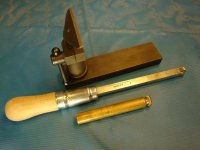Bradford72
Plastic
- Joined
- Mar 10, 2022
Hey all, I just got an Elgin lathe (plate says: Elgin Tool Works, 1770 Bertreau Ave At Ravenswood Ave, Chicago, ILL).
I'm sure it's obsolete, but perhaps there are ways I can modify it, or modify modern tooling to fit.
It was only $250, been sitting in an old semi trailer for years, and is intact. Surface rust, but even the grub screws came out no problem.
I did have to relocate a family of mice, from the head stock casing, but they'll be fine.
So...I'm looking for info, tooling, manuals...any and everything that y'all might be able to inform me about this lovely older gal.
I'm in the process of taking her apart, and getting ready to soak what I can in Evaporust.
Anything else will get scotchbrite and WD-40, or a mix of 50/50 lamp oil and synthetic motor oil, which I generally use as a go to bench oil.
Thanks loads in advance, and look forward to hearing from y'all!
I'm sure it's obsolete, but perhaps there are ways I can modify it, or modify modern tooling to fit.
It was only $250, been sitting in an old semi trailer for years, and is intact. Surface rust, but even the grub screws came out no problem.
I did have to relocate a family of mice, from the head stock casing, but they'll be fine.
So...I'm looking for info, tooling, manuals...any and everything that y'all might be able to inform me about this lovely older gal.
I'm in the process of taking her apart, and getting ready to soak what I can in Evaporust.
Anything else will get scotchbrite and WD-40, or a mix of 50/50 lamp oil and synthetic motor oil, which I generally use as a go to bench oil.
Thanks loads in advance, and look forward to hearing from y'all!




